Evaluating the Use of EHR by Nurses in Healthcare Settings
VerifiedAdded on 2022/09/21
|8
|2261
|34
Report
AI Summary
This report meticulously examines the utilization of Electronic Health Records (EHR) by nurses across diverse healthcare settings. It delves into the core components of EHR, including health information and data storage, management of results, order entry management, decision support, and electronic communication, highlighting how these elements facilitate efficient care delivery. The report assesses health information designs accurate for healthcare settings, focusing on EHR's impact on nurses' workflows and their ability to provide quality care. Furthermore, it investigates the integration of health information systems into strategic planning within nursing informatics, addressing the advantages and drawbacks of EHR implementation. The report also provides strategies to maximize safety, efficacy, and patient satisfaction through the effective use of EHR, emphasizing the importance of nurse education and data security. Ultimately, the report offers a comprehensive evaluation of EHR's influence on nursing practice and patient outcomes, providing valuable insights for healthcare professionals and researchers.
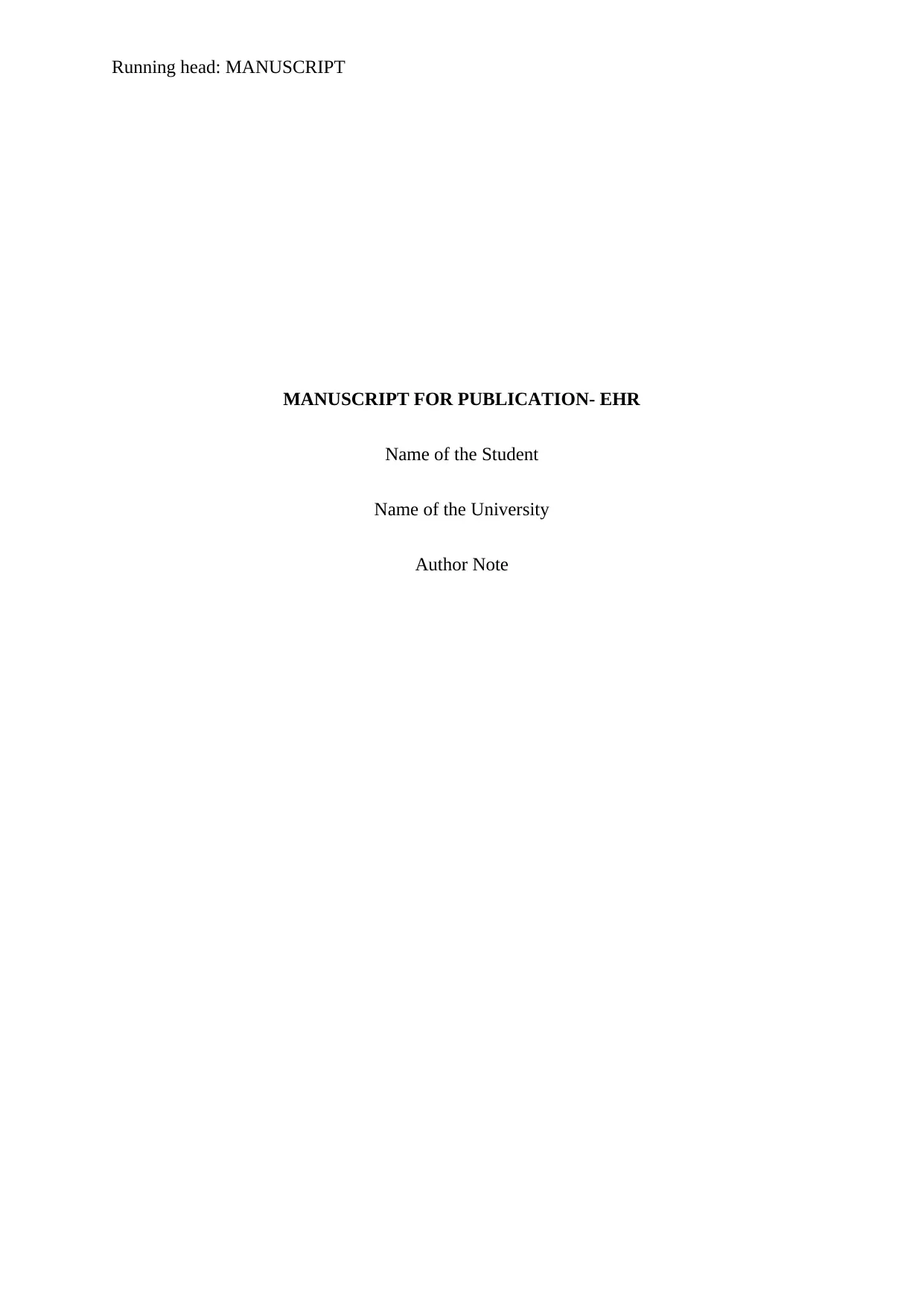
Running head: MANUSCRIPT
MANUSCRIPT FOR PUBLICATION- EHR
Name of the Student
Name of the University
Author Note
MANUSCRIPT FOR PUBLICATION- EHR
Name of the Student
Name of the University
Author Note
Paraphrase This Document
Need a fresh take? Get an instant paraphrase of this document with our AI Paraphraser
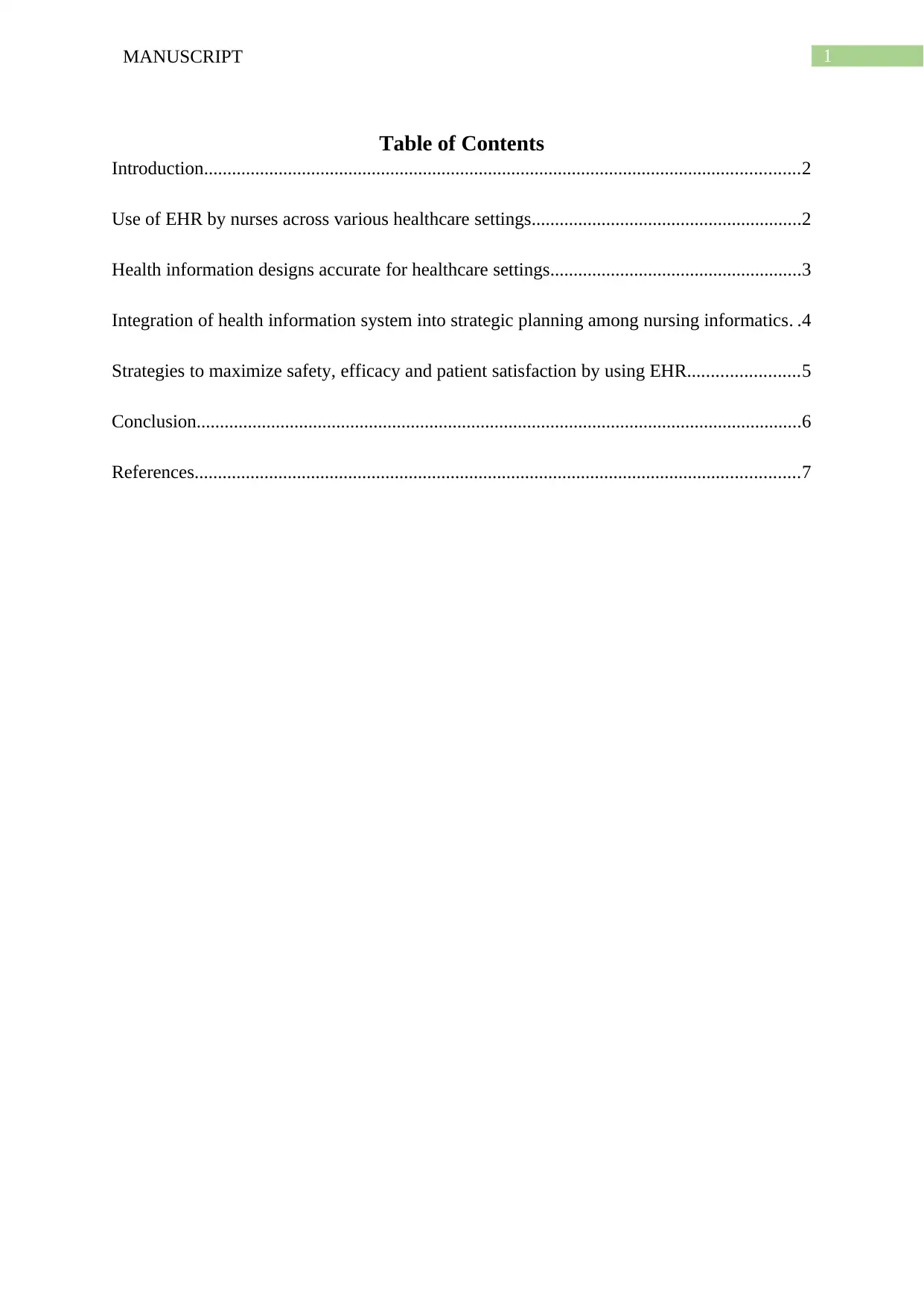
1MANUSCRIPT
Table of Contents
Introduction................................................................................................................................2
Use of EHR by nurses across various healthcare settings..........................................................2
Health information designs accurate for healthcare settings......................................................3
Integration of health information system into strategic planning among nursing informatics. .4
Strategies to maximize safety, efficacy and patient satisfaction by using EHR........................5
Conclusion..................................................................................................................................6
References..................................................................................................................................7
Table of Contents
Introduction................................................................................................................................2
Use of EHR by nurses across various healthcare settings..........................................................2
Health information designs accurate for healthcare settings......................................................3
Integration of health information system into strategic planning among nursing informatics. .4
Strategies to maximize safety, efficacy and patient satisfaction by using EHR........................5
Conclusion..................................................................................................................................6
References..................................................................................................................................7
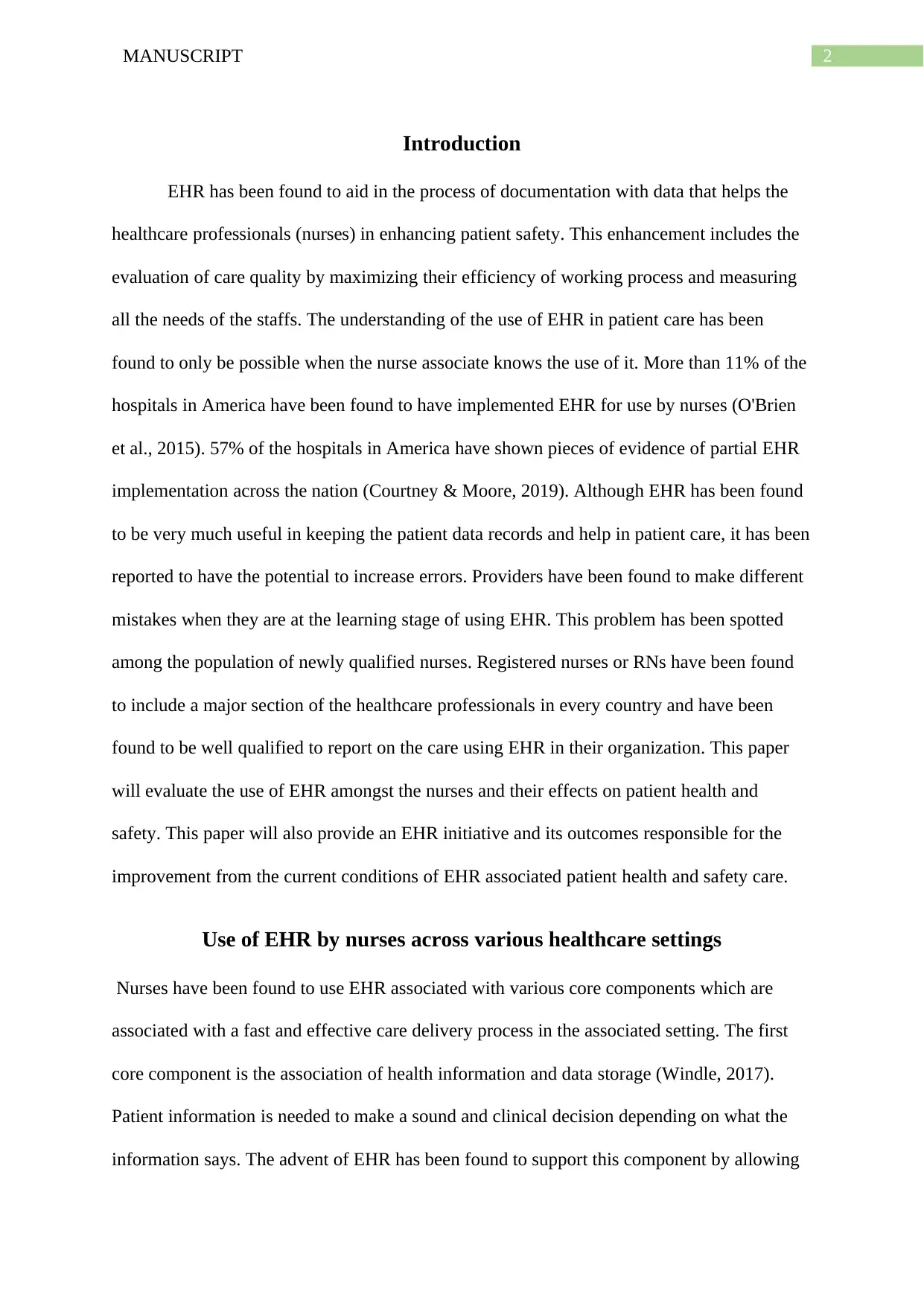
2MANUSCRIPT
Introduction
EHR has been found to aid in the process of documentation with data that helps the
healthcare professionals (nurses) in enhancing patient safety. This enhancement includes the
evaluation of care quality by maximizing their efficiency of working process and measuring
all the needs of the staffs. The understanding of the use of EHR in patient care has been
found to only be possible when the nurse associate knows the use of it. More than 11% of the
hospitals in America have been found to have implemented EHR for use by nurses (O'Brien
et al., 2015). 57% of the hospitals in America have shown pieces of evidence of partial EHR
implementation across the nation (Courtney & Moore, 2019). Although EHR has been found
to be very much useful in keeping the patient data records and help in patient care, it has been
reported to have the potential to increase errors. Providers have been found to make different
mistakes when they are at the learning stage of using EHR. This problem has been spotted
among the population of newly qualified nurses. Registered nurses or RNs have been found
to include a major section of the healthcare professionals in every country and have been
found to be well qualified to report on the care using EHR in their organization. This paper
will evaluate the use of EHR amongst the nurses and their effects on patient health and
safety. This paper will also provide an EHR initiative and its outcomes responsible for the
improvement from the current conditions of EHR associated patient health and safety care.
Use of EHR by nurses across various healthcare settings
Nurses have been found to use EHR associated with various core components which are
associated with a fast and effective care delivery process in the associated setting. The first
core component is the association of health information and data storage (Windle, 2017).
Patient information is needed to make a sound and clinical decision depending on what the
information says. The advent of EHR has been found to support this component by allowing
Introduction
EHR has been found to aid in the process of documentation with data that helps the
healthcare professionals (nurses) in enhancing patient safety. This enhancement includes the
evaluation of care quality by maximizing their efficiency of working process and measuring
all the needs of the staffs. The understanding of the use of EHR in patient care has been
found to only be possible when the nurse associate knows the use of it. More than 11% of the
hospitals in America have been found to have implemented EHR for use by nurses (O'Brien
et al., 2015). 57% of the hospitals in America have shown pieces of evidence of partial EHR
implementation across the nation (Courtney & Moore, 2019). Although EHR has been found
to be very much useful in keeping the patient data records and help in patient care, it has been
reported to have the potential to increase errors. Providers have been found to make different
mistakes when they are at the learning stage of using EHR. This problem has been spotted
among the population of newly qualified nurses. Registered nurses or RNs have been found
to include a major section of the healthcare professionals in every country and have been
found to be well qualified to report on the care using EHR in their organization. This paper
will evaluate the use of EHR amongst the nurses and their effects on patient health and
safety. This paper will also provide an EHR initiative and its outcomes responsible for the
improvement from the current conditions of EHR associated patient health and safety care.
Use of EHR by nurses across various healthcare settings
Nurses have been found to use EHR associated with various core components which are
associated with a fast and effective care delivery process in the associated setting. The first
core component is the association of health information and data storage (Windle, 2017).
Patient information is needed to make a sound and clinical decision depending on what the
information says. The advent of EHR has been found to support this component by allowing
⊘ This is a preview!⊘
Do you want full access?
Subscribe today to unlock all pages.

Trusted by 1+ million students worldwide
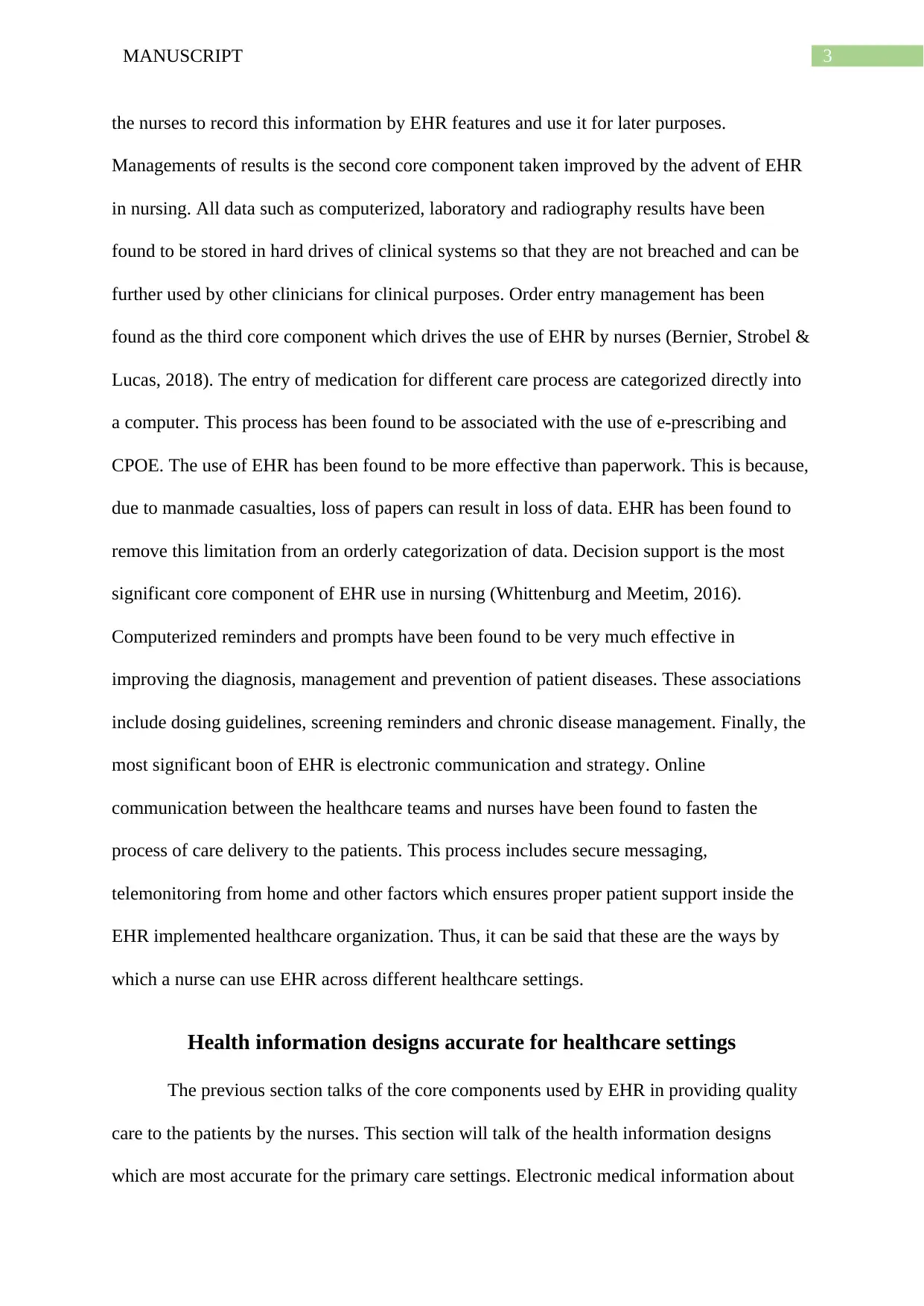
3MANUSCRIPT
the nurses to record this information by EHR features and use it for later purposes.
Managements of results is the second core component taken improved by the advent of EHR
in nursing. All data such as computerized, laboratory and radiography results have been
found to be stored in hard drives of clinical systems so that they are not breached and can be
further used by other clinicians for clinical purposes. Order entry management has been
found as the third core component which drives the use of EHR by nurses (Bernier, Strobel &
Lucas, 2018). The entry of medication for different care process are categorized directly into
a computer. This process has been found to be associated with the use of e-prescribing and
CPOE. The use of EHR has been found to be more effective than paperwork. This is because,
due to manmade casualties, loss of papers can result in loss of data. EHR has been found to
remove this limitation from an orderly categorization of data. Decision support is the most
significant core component of EHR use in nursing (Whittenburg and Meetim, 2016).
Computerized reminders and prompts have been found to be very much effective in
improving the diagnosis, management and prevention of patient diseases. These associations
include dosing guidelines, screening reminders and chronic disease management. Finally, the
most significant boon of EHR is electronic communication and strategy. Online
communication between the healthcare teams and nurses have been found to fasten the
process of care delivery to the patients. This process includes secure messaging,
telemonitoring from home and other factors which ensures proper patient support inside the
EHR implemented healthcare organization. Thus, it can be said that these are the ways by
which a nurse can use EHR across different healthcare settings.
Health information designs accurate for healthcare settings
The previous section talks of the core components used by EHR in providing quality
care to the patients by the nurses. This section will talk of the health information designs
which are most accurate for the primary care settings. Electronic medical information about
the nurses to record this information by EHR features and use it for later purposes.
Managements of results is the second core component taken improved by the advent of EHR
in nursing. All data such as computerized, laboratory and radiography results have been
found to be stored in hard drives of clinical systems so that they are not breached and can be
further used by other clinicians for clinical purposes. Order entry management has been
found as the third core component which drives the use of EHR by nurses (Bernier, Strobel &
Lucas, 2018). The entry of medication for different care process are categorized directly into
a computer. This process has been found to be associated with the use of e-prescribing and
CPOE. The use of EHR has been found to be more effective than paperwork. This is because,
due to manmade casualties, loss of papers can result in loss of data. EHR has been found to
remove this limitation from an orderly categorization of data. Decision support is the most
significant core component of EHR use in nursing (Whittenburg and Meetim, 2016).
Computerized reminders and prompts have been found to be very much effective in
improving the diagnosis, management and prevention of patient diseases. These associations
include dosing guidelines, screening reminders and chronic disease management. Finally, the
most significant boon of EHR is electronic communication and strategy. Online
communication between the healthcare teams and nurses have been found to fasten the
process of care delivery to the patients. This process includes secure messaging,
telemonitoring from home and other factors which ensures proper patient support inside the
EHR implemented healthcare organization. Thus, it can be said that these are the ways by
which a nurse can use EHR across different healthcare settings.
Health information designs accurate for healthcare settings
The previous section talks of the core components used by EHR in providing quality
care to the patients by the nurses. This section will talk of the health information designs
which are most accurate for the primary care settings. Electronic medical information about
Paraphrase This Document
Need a fresh take? Get an instant paraphrase of this document with our AI Paraphraser
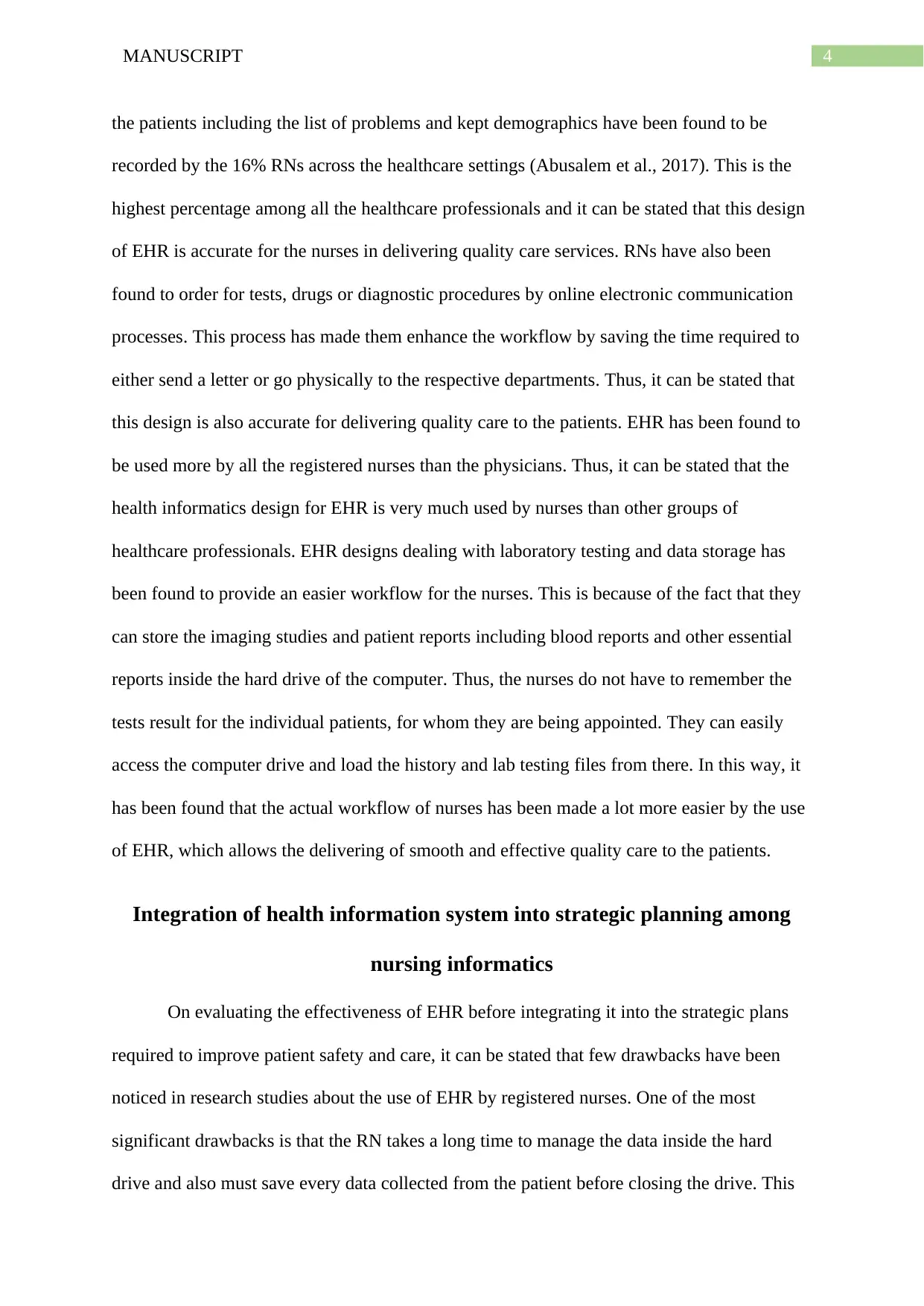
4MANUSCRIPT
the patients including the list of problems and kept demographics have been found to be
recorded by the 16% RNs across the healthcare settings (Abusalem et al., 2017). This is the
highest percentage among all the healthcare professionals and it can be stated that this design
of EHR is accurate for the nurses in delivering quality care services. RNs have also been
found to order for tests, drugs or diagnostic procedures by online electronic communication
processes. This process has made them enhance the workflow by saving the time required to
either send a letter or go physically to the respective departments. Thus, it can be stated that
this design is also accurate for delivering quality care to the patients. EHR has been found to
be used more by all the registered nurses than the physicians. Thus, it can be stated that the
health informatics design for EHR is very much used by nurses than other groups of
healthcare professionals. EHR designs dealing with laboratory testing and data storage has
been found to provide an easier workflow for the nurses. This is because of the fact that they
can store the imaging studies and patient reports including blood reports and other essential
reports inside the hard drive of the computer. Thus, the nurses do not have to remember the
tests result for the individual patients, for whom they are being appointed. They can easily
access the computer drive and load the history and lab testing files from there. In this way, it
has been found that the actual workflow of nurses has been made a lot more easier by the use
of EHR, which allows the delivering of smooth and effective quality care to the patients.
Integration of health information system into strategic planning among
nursing informatics
On evaluating the effectiveness of EHR before integrating it into the strategic plans
required to improve patient safety and care, it can be stated that few drawbacks have been
noticed in research studies about the use of EHR by registered nurses. One of the most
significant drawbacks is that the RN takes a long time to manage the data inside the hard
drive and also must save every data collected from the patient before closing the drive. This
the patients including the list of problems and kept demographics have been found to be
recorded by the 16% RNs across the healthcare settings (Abusalem et al., 2017). This is the
highest percentage among all the healthcare professionals and it can be stated that this design
of EHR is accurate for the nurses in delivering quality care services. RNs have also been
found to order for tests, drugs or diagnostic procedures by online electronic communication
processes. This process has made them enhance the workflow by saving the time required to
either send a letter or go physically to the respective departments. Thus, it can be stated that
this design is also accurate for delivering quality care to the patients. EHR has been found to
be used more by all the registered nurses than the physicians. Thus, it can be stated that the
health informatics design for EHR is very much used by nurses than other groups of
healthcare professionals. EHR designs dealing with laboratory testing and data storage has
been found to provide an easier workflow for the nurses. This is because of the fact that they
can store the imaging studies and patient reports including blood reports and other essential
reports inside the hard drive of the computer. Thus, the nurses do not have to remember the
tests result for the individual patients, for whom they are being appointed. They can easily
access the computer drive and load the history and lab testing files from there. In this way, it
has been found that the actual workflow of nurses has been made a lot more easier by the use
of EHR, which allows the delivering of smooth and effective quality care to the patients.
Integration of health information system into strategic planning among
nursing informatics
On evaluating the effectiveness of EHR before integrating it into the strategic plans
required to improve patient safety and care, it can be stated that few drawbacks have been
noticed in research studies about the use of EHR by registered nurses. One of the most
significant drawbacks is that the RN takes a long time to manage the data inside the hard
drive and also must save every data collected from the patient before closing the drive. This
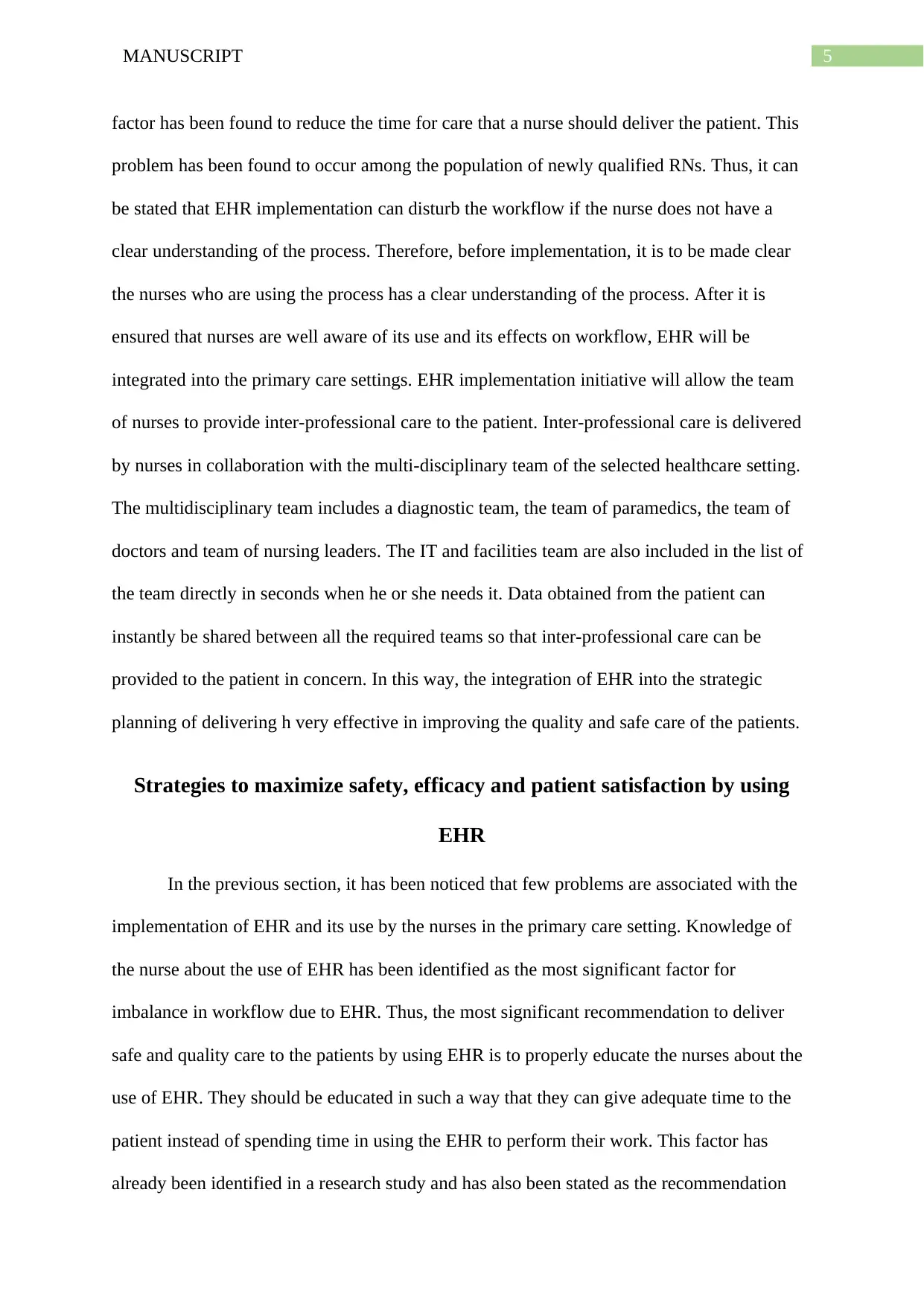
5MANUSCRIPT
factor has been found to reduce the time for care that a nurse should deliver the patient. This
problem has been found to occur among the population of newly qualified RNs. Thus, it can
be stated that EHR implementation can disturb the workflow if the nurse does not have a
clear understanding of the process. Therefore, before implementation, it is to be made clear
the nurses who are using the process has a clear understanding of the process. After it is
ensured that nurses are well aware of its use and its effects on workflow, EHR will be
integrated into the primary care settings. EHR implementation initiative will allow the team
of nurses to provide inter-professional care to the patient. Inter-professional care is delivered
by nurses in collaboration with the multi-disciplinary team of the selected healthcare setting.
The multidisciplinary team includes a diagnostic team, the team of paramedics, the team of
doctors and team of nursing leaders. The IT and facilities team are also included in the list of
the team directly in seconds when he or she needs it. Data obtained from the patient can
instantly be shared between all the required teams so that inter-professional care can be
provided to the patient in concern. In this way, the integration of EHR into the strategic
planning of delivering h very effective in improving the quality and safe care of the patients.
Strategies to maximize safety, efficacy and patient satisfaction by using
EHR
In the previous section, it has been noticed that few problems are associated with the
implementation of EHR and its use by the nurses in the primary care setting. Knowledge of
the nurse about the use of EHR has been identified as the most significant factor for
imbalance in workflow due to EHR. Thus, the most significant recommendation to deliver
safe and quality care to the patients by using EHR is to properly educate the nurses about the
use of EHR. They should be educated in such a way that they can give adequate time to the
patient instead of spending time in using the EHR to perform their work. This factor has
already been identified in a research study and has also been stated as the recommendation
factor has been found to reduce the time for care that a nurse should deliver the patient. This
problem has been found to occur among the population of newly qualified RNs. Thus, it can
be stated that EHR implementation can disturb the workflow if the nurse does not have a
clear understanding of the process. Therefore, before implementation, it is to be made clear
the nurses who are using the process has a clear understanding of the process. After it is
ensured that nurses are well aware of its use and its effects on workflow, EHR will be
integrated into the primary care settings. EHR implementation initiative will allow the team
of nurses to provide inter-professional care to the patient. Inter-professional care is delivered
by nurses in collaboration with the multi-disciplinary team of the selected healthcare setting.
The multidisciplinary team includes a diagnostic team, the team of paramedics, the team of
doctors and team of nursing leaders. The IT and facilities team are also included in the list of
the team directly in seconds when he or she needs it. Data obtained from the patient can
instantly be shared between all the required teams so that inter-professional care can be
provided to the patient in concern. In this way, the integration of EHR into the strategic
planning of delivering h very effective in improving the quality and safe care of the patients.
Strategies to maximize safety, efficacy and patient satisfaction by using
EHR
In the previous section, it has been noticed that few problems are associated with the
implementation of EHR and its use by the nurses in the primary care setting. Knowledge of
the nurse about the use of EHR has been identified as the most significant factor for
imbalance in workflow due to EHR. Thus, the most significant recommendation to deliver
safe and quality care to the patients by using EHR is to properly educate the nurses about the
use of EHR. They should be educated in such a way that they can give adequate time to the
patient instead of spending time in using the EHR to perform their work. This factor has
already been identified in a research study and has also been stated as the recommendation
⊘ This is a preview!⊘
Do you want full access?
Subscribe today to unlock all pages.

Trusted by 1+ million students worldwide
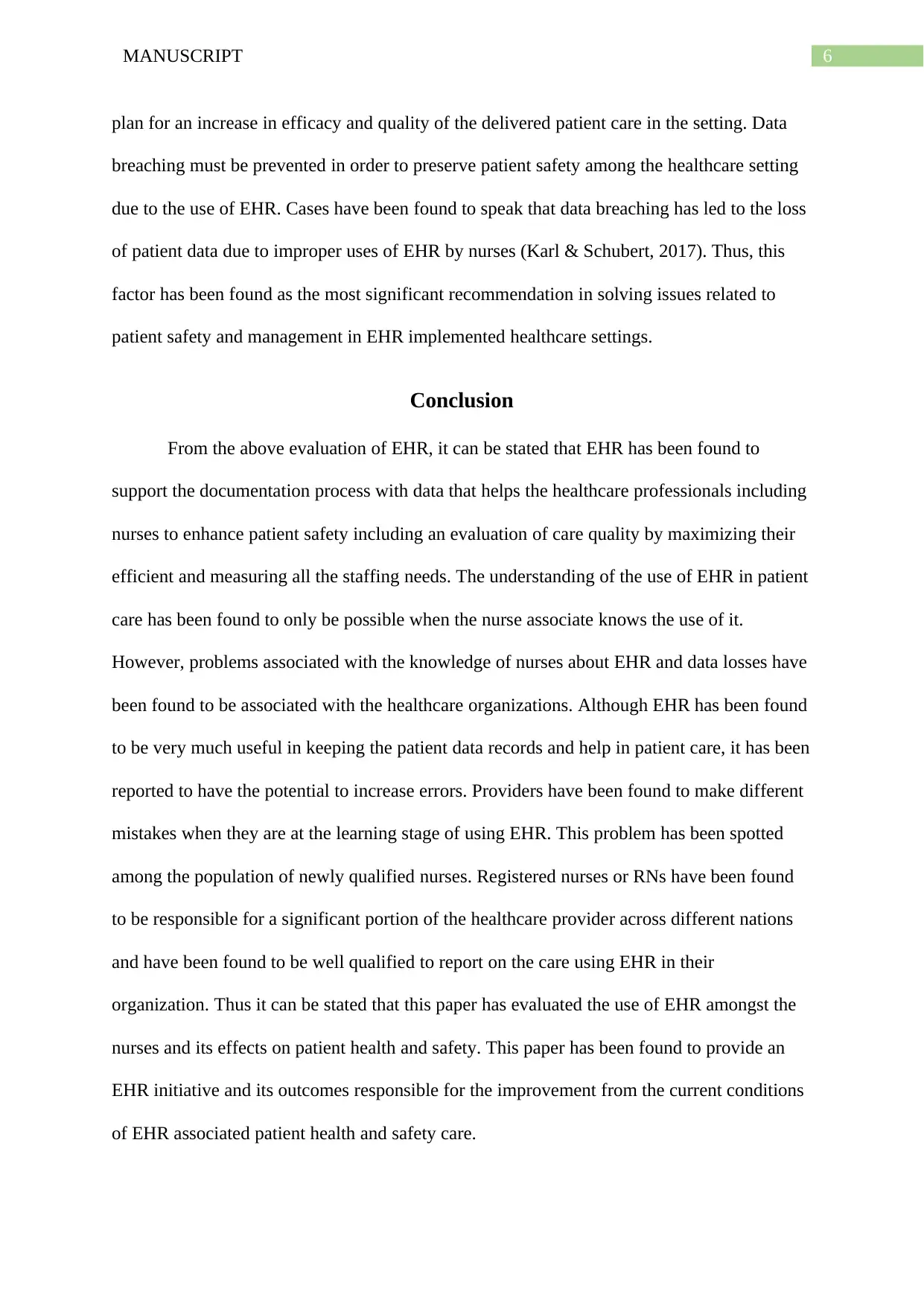
6MANUSCRIPT
plan for an increase in efficacy and quality of the delivered patient care in the setting. Data
breaching must be prevented in order to preserve patient safety among the healthcare setting
due to the use of EHR. Cases have been found to speak that data breaching has led to the loss
of patient data due to improper uses of EHR by nurses (Karl & Schubert, 2017). Thus, this
factor has been found as the most significant recommendation in solving issues related to
patient safety and management in EHR implemented healthcare settings.
Conclusion
From the above evaluation of EHR, it can be stated that EHR has been found to
support the documentation process with data that helps the healthcare professionals including
nurses to enhance patient safety including an evaluation of care quality by maximizing their
efficient and measuring all the staffing needs. The understanding of the use of EHR in patient
care has been found to only be possible when the nurse associate knows the use of it.
However, problems associated with the knowledge of nurses about EHR and data losses have
been found to be associated with the healthcare organizations. Although EHR has been found
to be very much useful in keeping the patient data records and help in patient care, it has been
reported to have the potential to increase errors. Providers have been found to make different
mistakes when they are at the learning stage of using EHR. This problem has been spotted
among the population of newly qualified nurses. Registered nurses or RNs have been found
to be responsible for a significant portion of the healthcare provider across different nations
and have been found to be well qualified to report on the care using EHR in their
organization. Thus it can be stated that this paper has evaluated the use of EHR amongst the
nurses and its effects on patient health and safety. This paper has been found to provide an
EHR initiative and its outcomes responsible for the improvement from the current conditions
of EHR associated patient health and safety care.
plan for an increase in efficacy and quality of the delivered patient care in the setting. Data
breaching must be prevented in order to preserve patient safety among the healthcare setting
due to the use of EHR. Cases have been found to speak that data breaching has led to the loss
of patient data due to improper uses of EHR by nurses (Karl & Schubert, 2017). Thus, this
factor has been found as the most significant recommendation in solving issues related to
patient safety and management in EHR implemented healthcare settings.
Conclusion
From the above evaluation of EHR, it can be stated that EHR has been found to
support the documentation process with data that helps the healthcare professionals including
nurses to enhance patient safety including an evaluation of care quality by maximizing their
efficient and measuring all the staffing needs. The understanding of the use of EHR in patient
care has been found to only be possible when the nurse associate knows the use of it.
However, problems associated with the knowledge of nurses about EHR and data losses have
been found to be associated with the healthcare organizations. Although EHR has been found
to be very much useful in keeping the patient data records and help in patient care, it has been
reported to have the potential to increase errors. Providers have been found to make different
mistakes when they are at the learning stage of using EHR. This problem has been spotted
among the population of newly qualified nurses. Registered nurses or RNs have been found
to be responsible for a significant portion of the healthcare provider across different nations
and have been found to be well qualified to report on the care using EHR in their
organization. Thus it can be stated that this paper has evaluated the use of EHR amongst the
nurses and its effects on patient health and safety. This paper has been found to provide an
EHR initiative and its outcomes responsible for the improvement from the current conditions
of EHR associated patient health and safety care.
Paraphrase This Document
Need a fresh take? Get an instant paraphrase of this document with our AI Paraphraser
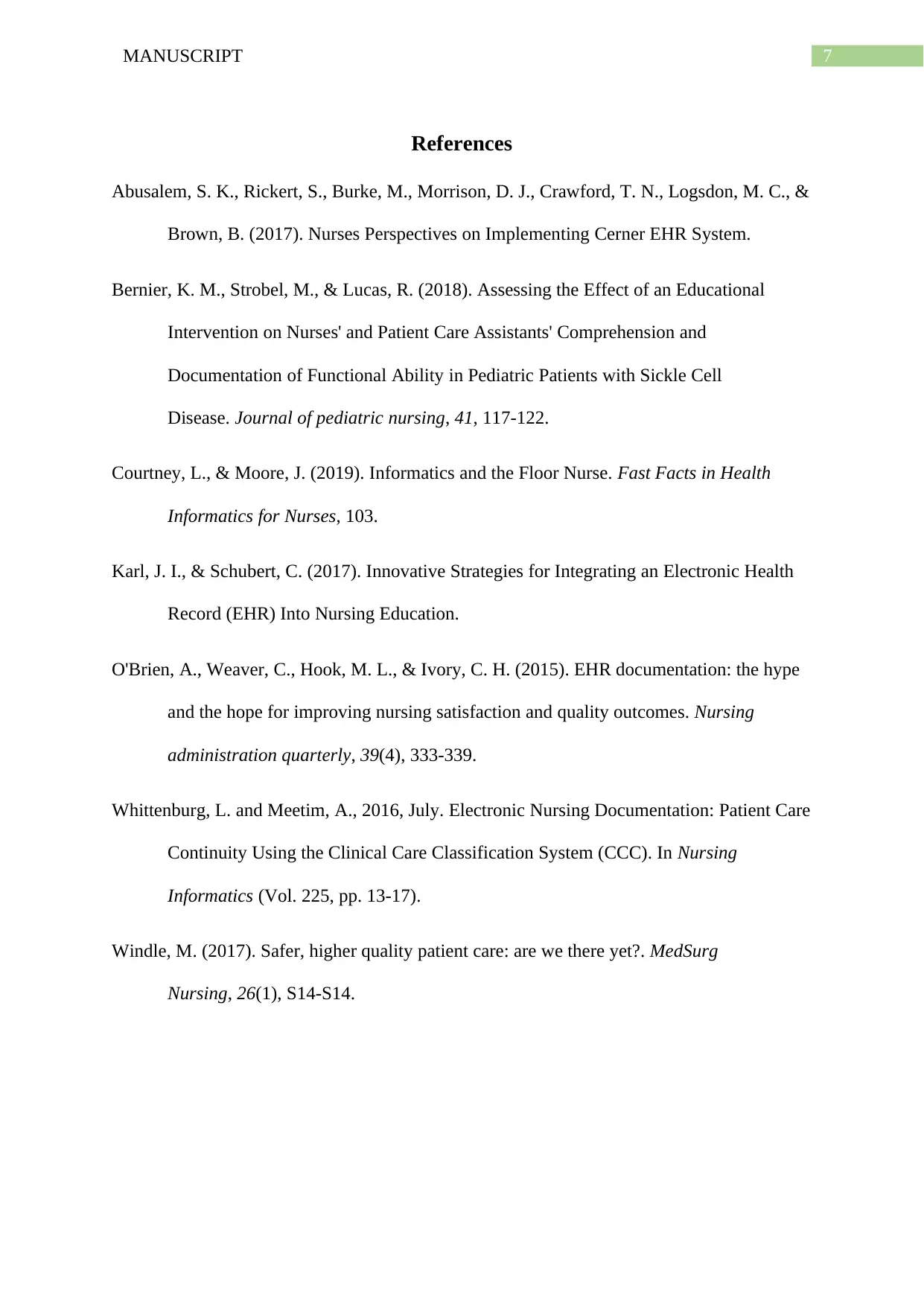
7MANUSCRIPT
References
Abusalem, S. K., Rickert, S., Burke, M., Morrison, D. J., Crawford, T. N., Logsdon, M. C., &
Brown, B. (2017). Nurses Perspectives on Implementing Cerner EHR System.
Bernier, K. M., Strobel, M., & Lucas, R. (2018). Assessing the Effect of an Educational
Intervention on Nurses' and Patient Care Assistants' Comprehension and
Documentation of Functional Ability in Pediatric Patients with Sickle Cell
Disease. Journal of pediatric nursing, 41, 117-122.
Courtney, L., & Moore, J. (2019). Informatics and the Floor Nurse. Fast Facts in Health
Informatics for Nurses, 103.
Karl, J. I., & Schubert, C. (2017). Innovative Strategies for Integrating an Electronic Health
Record (EHR) Into Nursing Education.
O'Brien, A., Weaver, C., Hook, M. L., & Ivory, C. H. (2015). EHR documentation: the hype
and the hope for improving nursing satisfaction and quality outcomes. Nursing
administration quarterly, 39(4), 333-339.
Whittenburg, L. and Meetim, A., 2016, July. Electronic Nursing Documentation: Patient Care
Continuity Using the Clinical Care Classification System (CCC). In Nursing
Informatics (Vol. 225, pp. 13-17).
Windle, M. (2017). Safer, higher quality patient care: are we there yet?. MedSurg
Nursing, 26(1), S14-S14.
References
Abusalem, S. K., Rickert, S., Burke, M., Morrison, D. J., Crawford, T. N., Logsdon, M. C., &
Brown, B. (2017). Nurses Perspectives on Implementing Cerner EHR System.
Bernier, K. M., Strobel, M., & Lucas, R. (2018). Assessing the Effect of an Educational
Intervention on Nurses' and Patient Care Assistants' Comprehension and
Documentation of Functional Ability in Pediatric Patients with Sickle Cell
Disease. Journal of pediatric nursing, 41, 117-122.
Courtney, L., & Moore, J. (2019). Informatics and the Floor Nurse. Fast Facts in Health
Informatics for Nurses, 103.
Karl, J. I., & Schubert, C. (2017). Innovative Strategies for Integrating an Electronic Health
Record (EHR) Into Nursing Education.
O'Brien, A., Weaver, C., Hook, M. L., & Ivory, C. H. (2015). EHR documentation: the hype
and the hope for improving nursing satisfaction and quality outcomes. Nursing
administration quarterly, 39(4), 333-339.
Whittenburg, L. and Meetim, A., 2016, July. Electronic Nursing Documentation: Patient Care
Continuity Using the Clinical Care Classification System (CCC). In Nursing
Informatics (Vol. 225, pp. 13-17).
Windle, M. (2017). Safer, higher quality patient care: are we there yet?. MedSurg
Nursing, 26(1), S14-S14.
1 out of 8
Related Documents
Your All-in-One AI-Powered Toolkit for Academic Success.
+13062052269
info@desklib.com
Available 24*7 on WhatsApp / Email
![[object Object]](/_next/static/media/star-bottom.7253800d.svg)
Unlock your academic potential
Copyright © 2020–2025 A2Z Services. All Rights Reserved. Developed and managed by ZUCOL.





